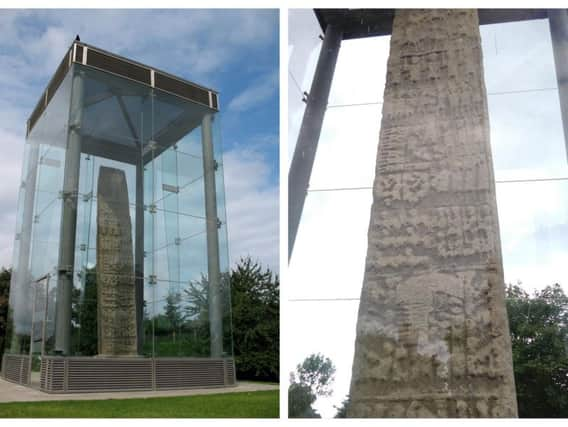The mysteries of Scotland's tallest standing stone


Centuries after it was first created, Sueno's Stone on the outskirts of Forres in Moray continues to intrigue and fascinate.
The gigantic Pictish cross-slab measures 7 metres tall - the tallest piece of early historic sculpture in Scotland - with its carvings jailed as ornate and unique.
Advertisement
Hide AdAdvertisement
Hide AdIn its day, it would have stood on a prominent mound in the heartland of Pictish Moray and possibly marked the main eastern approach into medieval Forres.
Depicted on one side is a rare and complex battle scene which features headless corpses, toe-to-toe fighting and a group of horseback fighters fleeing from infantrymen.
Here, two bearded figures face each other and stoop over what appears to be a central seated figure. Two smaller attendants stand behind.
No such scene has ever been found before on stones of this age and style.
But who was the King?
Tradition states it is named after Svein Forkbeard, a Danish ruler from the 11th Century, although Historic Environment Scotland believes this theory is entirely without foundation.
Some believe the conflict depicts a battle between Cinaed mac Ailpín, or a descendant, and the Picts of Moray, with the inauguration that of a mac Ailpín king.
Others say the battle shown was that fought by Dubh mac Ailpín, who was killed at Forres in 966.
But, it is is hard to prove if the events depicted in the stone actually happened - and who ordered the stone to show them.
Advertisement
Hide AdAdvertisement
Hide AdHES said the scale and the complexity of the story told on the stone "invites superlatives as well as speculation".
"The cross-slab .. helps provide an insight into the minds, cultural resources and foreign contacts of the Picts, and reminds us that they were not remote barbarians.
"Its scale and ambition is important too, as it is the largest of its type known to survive," a statement from HES said.
The first known repair of the stone came around 1700 when Lady Ann Campbel, countess of Moray, ordered some work to place stone steps around its bases. Such was the interest in the Pictish monument, that admission was charged to see it around the 1860s.
By 1923, the stone was taken into state care, and there was chat in the 1980s to move it in to the Falconer Museum in Forres, which was flatly rejected given the importance of its original location.
In 1991, Sueno's Stone was covered by a glass box for protection and it is estimated that 5,000 people a year now come off the nearby A96 to stop and look at this most remarkable ancients stone now preserved in the most modern of ways.